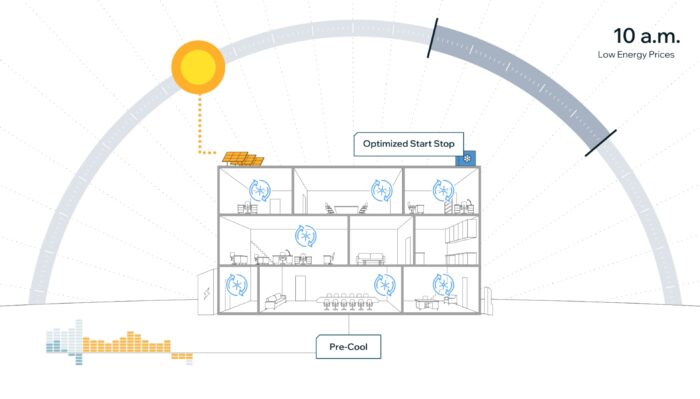Report on Integrated Energy Management Systems as a Catalyst for Sustainable Development Goals
This report analyzes the integration of building load control with on-site solar and energy storage systems. It highlights how unified software platforms contribute significantly to achieving several United Nations Sustainable Development Goals (SDGs) by optimizing energy consumption, enhancing grid stability, and promoting renewable energy adoption.
Advancing SDG 7 (Affordable and Clean Energy) and SDG 12 (Responsible Consumption)
The traditional separation of Building Management Systems (BMS) from energy storage solutions results in significant inefficiencies and financial losses. Integrated platforms address this challenge by creating a cohesive system that aligns with key sustainability targets.
- Energy Efficiency: By synchronizing major loads like HVAC and EV charging with solar generation, battery dispatch, and real-time utility price signals, these systems eliminate artificial energy peaks. This directly supports SDG 7.3 by improving energy efficiency.
- Renewable Energy Optimization: Coordinated control ensures that energy generated from on-site solar is utilized most effectively, either by powering loads directly, charging batteries, or responding to grid needs. This increases the share of renewable energy in the building’s consumption mix, aligning with SDG 7.2.
- Sustainable Consumption Patterns: The technology automates energy use to avoid waste and high-cost periods, fostering more responsible consumption patterns within commercial operations, a core principle of SDG 12.
Fostering Innovation and Resilient Infrastructure (SDG 9 & SDG 11)
The development of software that merges load control with energy assets represents a critical innovation for creating sustainable and resilient infrastructure. Pilot programs with utilities demonstrate a new paradigm for grid management.
- Technological Innovation (SDG 9): Platforms like Elexity provide an innovative technological solution that upgrades existing infrastructure, making commercial buildings active and intelligent participants in the energy grid.
- Grid Resilience (SDG 11): Utility-led initiatives, such as those by Southern California Edison (SCE) and Tucson Electric, use integrated load control as a tool to shape demand, manage grid reliability, and reduce procurement costs. This enhances the sustainability and resilience of urban energy systems, contributing to SDG 11.
- Smart Infrastructure Development: These systems transform buildings into flexible grid assets, which is essential for accommodating variable renewable energy sources and building the resilient infrastructure required by SDG 9.
Driving Climate Action and Strategic Implementation (SDG 13)
The operational capabilities of integrated energy systems provide a direct pathway to climate change mitigation by reducing reliance on fossil fuels and enabling a more agile, renewables-based grid.
Southern California Edison Pilot Project
The SCE pilot project exemplifies the model’s contribution to SDG 13 (Climate Action):
- Objective: To reduce the “duck curve” effect, align energy loads with generation capacity, and avoid the use of fossil-fuel peaker plants.
- Method: Elexity’s platform was used to automatically control approximately 3 MW of customer loads in response to day-ahead hourly price signals. Phase 2 will scale this to over 8 MW and integrate battery storage.
- Outcome: The project demonstrates a scalable method for shaping load to match renewable generation, directly reducing greenhouse gas emissions.
Tucson Electric Program
This pilot focuses on deploying load control as a form of grid infrastructure, giving the utility the ability to align supply and demand without disrupting customers, further supporting the goals of grid decarbonization under SDG 13.
Recommendations for Developers and EPCs to Support SDGs
To maximize the sustainability impact of energy projects, developers and EPCs should adopt the following strategic approaches:
- Treat the Building as an Integrated Asset: Modeling and deploying solar and storage projects must include coordinated load control. This holistic approach ensures more reliable energy savings and maximizes the project’s contribution to SDG 7 and SDG 13.
- Implement Phased Deployments Starting with Load Control: Begin customer engagement with fast-to-install load control systems. This approach provides immediate financial returns and energy savings, which can fund subsequent solar and battery installations, creating a sustainable business model for advancing clean energy infrastructure (SDG 9).
- Prepare for a Future of Dynamic Energy Pricing: As utilities increasingly adopt time-based pricing, platforms that offer automated, real-time control will become essential. Proactively adopting this technology positions projects for long-term value and resilience, supporting the creation of sustainable communities (SDG 11).
Analysis of Sustainable Development Goals in the Article
1. Which SDGs are addressed or connected to the issues highlighted in the article?
The article discusses the integration of building load control, solar energy, and battery storage, which connects to several Sustainable Development Goals (SDGs). The primary goals addressed are:
- SDG 7: Affordable and Clean Energy: The core of the article focuses on making energy use more efficient, integrating renewable energy (solar), and ensuring a stable supply through smart technology. This directly aligns with providing clean and affordable energy.
- SDG 9: Industry, Innovation, and Infrastructure: The article highlights innovative software platforms like Elexity that are upgrading building infrastructure. This technology represents a significant innovation in energy management, making industrial and commercial infrastructure more sustainable and efficient.
- SDG 11: Sustainable Cities and Communities: By managing energy demand at the building level, the technology discussed helps create more resilient and sustainable urban energy systems. The pilot programs with utilities like Southern California Edison and Tucson Electric are examples of creating smarter city infrastructure to handle energy loads efficiently.
- SDG 13: Climate Action: The article implicitly addresses climate action. By improving energy efficiency, integrating solar power, and reducing peak demand, the system reduces the need for fossil-fuel-based “peaker plants.” This helps to lower greenhouse gas emissions and integrate climate change mitigation strategies into energy infrastructure planning.
2. What specific targets under those SDGs can be identified based on the article’s content?
Based on the article’s content, several specific SDG targets can be identified:
-
Under SDG 7 (Affordable and Clean Energy):
- Target 7.2: “By 2030, increase substantially the share of renewable energy in the global energy mix.” The article promotes the integration of on-site solar power with battery storage and load management, which directly contributes to increasing the share of renewable energy used by commercial buildings.
- Target 7.3: “By 2030, double the global rate of improvement in energy efficiency.” The entire premise of the Elexity platform is to improve energy efficiency by coordinating building loads (like HVAC) with energy generation and storage, thereby preventing energy waste and reducing overall consumption during peak price hours. The article states that “the AC kicking on Monday morning can account for as much as 70% of a commercial energy bill,” highlighting the massive potential for efficiency gains.
-
Under SDG 9 (Industry, Innovation, and Infrastructure):
- Target 9.4: “By 2030, upgrade infrastructure and retrofit industries to make them sustainable, with increased resource-use efficiency and greater adoption of clean and environmentally sound technologies…” The article describes retrofitting commercial buildings with advanced software that acts as a “control backbone” to manage energy resources efficiently. This is a direct example of upgrading infrastructure with clean and sustainable technology.
-
Under SDG 11 (Sustainable Cities and Communities):
- Target 11.b: “By 2030, substantially increase the number of cities and human settlements adopting and implementing integrated policies and plans towards… resource efficiency, [and] mitigation and adaptation to climate change…” The pilot projects with Southern California Edison (SCE) and Tucson Electric are examples of utilities implementing integrated plans for demand-side resource efficiency to create a more stable and efficient grid.
3. Are there any indicators mentioned or implied in the article that can be used to measure progress towards the identified targets?
Yes, the article mentions several quantitative and qualitative indicators that can be used to measure progress:
-
Indicator for Energy Efficiency and Economic Viability (Target 7.3): The article provides specific financial metrics that serve as indicators of success.
- Monetary Savings: It mentions that a “125-kW battery might deliver about $25,000 per year in savings,” and that adding load control leads to “more than a 50% improvement on the economics.”
- Return on Investment: The article notes that load control software can have a “sub-one-year payback in demand-heavy markets.”
-
Indicator for Technology Adoption and Infrastructure Upgrades (Target 9.4): The scale of implementation is a key indicator.
- Managed Electrical Load: The SCE pilot project is described as “controlling about 3 MW of customer loads,” with a plan to “scale past 8 MW.” This measures the capacity of upgraded infrastructure.
- Number of Upgraded Units: The Tucson Electric pilot “covers 10 buildings,” providing a clear count of retrofitted sites.
-
Indicator for Integrated Planning (Target 11.b): The existence and expansion of utility-led programs serve as an indicator.
- Number of Utility Programs: The article explicitly names two pilot programs (Southern California Edison and Tucson Electric), indicating the adoption of these integrated strategies by major utility providers.
4. Summary Table of SDGs, Targets, and Indicators
| SDGs | Targets | Indicators |
|---|---|---|
| SDG 7: Affordable and Clean Energy |
7.2: Increase substantially the share of renewable energy.
7.3: Double the global rate of improvement in energy efficiency. |
– Increased installation of on-site solar and battery systems in commercial buildings. – Monetary savings from energy management (e.g., “$25,000 per year in savings,” “50% improvement on the economics”). – Payback period for technology investment (e.g., “sub-one-year payback”). |
| SDG 9: Industry, Innovation and Infrastructure | 9.4: Upgrade infrastructure and retrofit industries to make them sustainable… with greater adoption of clean… technologies. |
– Amount of electrical load under smart management (e.g., “3 MW of customer loads” scaling to “8 MW”). – Number of buildings/facilities adopting integrated control platforms (e.g., “initial test covers 10 buildings”). |
| SDG 11: Sustainable Cities and Communities | 11.b: Increase the number of cities… adopting and implementing integrated policies and plans towards… resource efficiency. | – Number of utility-run pilot programs focused on load control and demand response (e.g., Southern California Edison and Tucson Electric pilots). |
| SDG 13: Climate Action | 13.2: Integrate climate change measures into… policies, strategies and planning. | – Implementation of grid-level strategies to reduce reliance on peaker plants by shaping load to align with renewable generation (e.g., SCE’s goal to “reduce the duck curve”). |
Source: solarbuildermag.com





![[Latest] Europe Energy Management Systems Ems Market Trends to Watch: Growth and Investment – openPR.com [Latest] Europe Energy Management Systems Ems Market Trends to Watch: Growth and Investment – openPR.com](https://cdn.open-pr.com/L/a/La23610616_g.jpg)

